Discovering Yooperlites: The Glow of Michigan's Gem
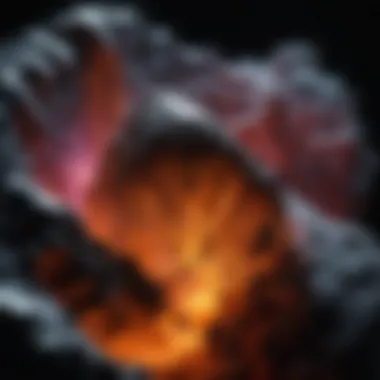
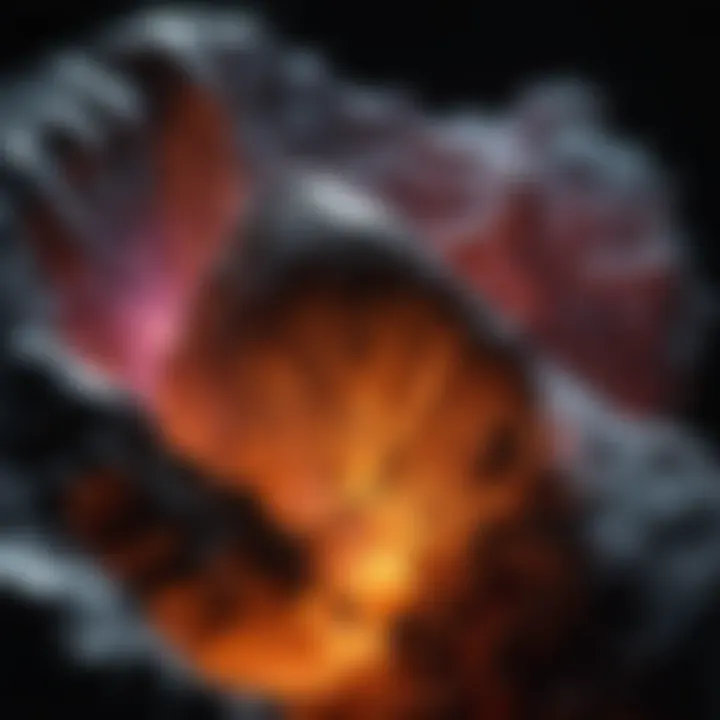
Intro
When you wander through Michigan's Upper Peninsula, you may stumble upon an intriguing geological gem: the yooperlite. These unique rocks possess a mesmerizing characteristic that sets them apart from the ordinary: they glow under black light, revealing a secret world that eludes the untrained eye. To the uninitiated, yooperlites might seem like any other rock, but those in the know cherish them for their distinctive luminescence, found primarily in syenite, showcasing sodalite as the core mineral.
This article invites both enthusiasts and curious newcomers to delve into the captivating realm of yooperlites. We're breaking down their geological origins, how to best identify and collect these stones, and essential preservation techniques to ensure they last for years to come. Get ready to shine a light on your understanding of these dazzling rocks!
Featured Collectible of the Month
Overview
Yooperlites aren't just collectibles; they are vibrant science in stone form. What truly sets them apart is their luminescence, which can capture the attention of any rock hound. The glow of yooperlites stems from the presence of sodalite, a mineral that reacts vividly under ultraviolet light. Collectors often report feelings of euphoria upon first seeing their yooperlites light up, almost as if the stones come alive, presenting themselves in an entirely new way.
Historical Significance
The discovery of yooperlites is a relatively recent tale in the world of geology. They were first identified in the early 2010s by Eric A. A. Sadar, a self-proclaimed rock hound. His discovery opened a treasure trove for local collectors and hikers, igniting a passion that has continued to grow among hobbyists and professionals alike. In a way, these gems have created a community taking pride in their geological heritage, knitting together the threads of science, adventure, and personal connection.
"The joy in collecting yooperlites lies not just in the stones themselves, but in the stories they tell and the friendships formed along the way."
Identification Techniques
When it comes to identifying yooperlites, there are a few techniques worth mastering. Understanding their visual characteristics is crucial for enthusiasts and collectors.
Visual Characteristics
In natural light, yooperlites might seem fairly unremarkable. However, under black light—or ultraviolet light—they burst into life. Here are some traits to look for:
- Coloration: Typically, yooperlites will appear gray or dull in natural light, but under UV light, they transform into bright shades of orange-yellow.
- Textures: These rocks often have a rough or bumpy texture. Look closely; a true yooperlite usually has sparkling inclusions of sodalite.
- Location: Many are found along the shores of Lake Superior, especially after storms or in weathered areas. Don’t forget to search in gravelly spots—the best is often where the earth has shifted and turned up new treasures.
Resources for Identification
For those keen on expanding their knowledge and honing their identification skills, several excellent resources are available:
- Wikipedia: Yooperlite - A concise overview of what yooperlites are.
- Britannica: Geological Features - Delve deeper into the geology of the Upper Peninsula's rocks.
- Reddit - Join communities and forums that discuss rock collecting—perfect for sharing experiences and tips.
- Facebook Groups – There are many active communities dedicated to yooperlite enthusiasts, where one can learn more about collection strategies and share personal finds.
Prelude to Yooperlites
When venturing into the world of geology, one stumbles upon the enchanting allure of Yooperlites, a remarkable type of syenite that captivates not just the eyes but the minds of enthusiasts and collectors alike. With their distinct luminescent properties, they provide ample opportunities for exploration and discovery. In this section, we’ll take a closer look at what Yooperlites are, how they formed, and why they matter to both casual rock hounds and serious geologists.
What are Yooperlites?
Yooperlites are more than just a curiosity; they are a unique geological phenomenon found primarily in Michigan’s Upper Peninsula. What sets them apart is their ability to glow under black light, revealing bright hues that can take anyone by surprise. This glow is attributed to the presence of sodalite, a mineral that thrives in their composition. Described as flakes of stardust by some enthusiasts, these stones not only appeal visually but also spark questions about their origins and formation.
Geological Composition
Understanding the geological composition of Yooperlites allows enthusiasts to appreciate their significance fully. They are primarily made from a specific type of rock characterized by intriguing mineral constituents and a distinct journey of regional formation.
Mineral Constituents
The mineral composition of Yooperlites plays a crucial role in their luminescent properties. The star player here, sodalite, is a feldspathoid mineral closely related to the more common feldspar. One might say that sodalite is like a flavor enhancer for rocks – adding not only color but also depth to the overall experience.
- Key Characteristic: The fluorescent quality of sodalite is what keeps collectors coming back for more. When exposed to ultraviolet light, these stones exhibit bright blue to violet hues, a stark contrast to their unlit appearance.
- Unique Feature: Their rarity and the trade-offs of locating them at night make them a hot commodity among rock hounds.
In this context, understanding sodalite's role in Yooperlites not only helps in identifying them but also contributes to a larger conversation about mineral diversity in geological studies.
Regional Formation
When we consider regional formation, it's much like tracing the history of an ancient tale. Yooperlites have origins steeped in the volcanic activity that occurred over a billion years ago. Their development is tied to the cooling processes of magma, which enriched the region with unique mineral deposits.
- Key Characteristic: The Upper Peninsula's geological landscape is dotted with different rock types, but the specific conditions that favoured syenite formation make it a particularly interesting case.
- Unique Feature: The unique geological pattern lays out a narrative of how environmental factors such as weathering, erosion, and sedimentation interact.
Through examining the regional formation, we can draw conclusions about the longstanding history of Michigan's natural landscapes, contributing valuable insights into environmental changes through millennia.
Discovery and Attribution
The quest for Yooperlites not just fosters excitement among collectors but also involves the pivotal contributions of local geologists and a rich cultural background. Understanding the role of some community stakeholders can greatly enhance one’s appreciation of these geological gems.
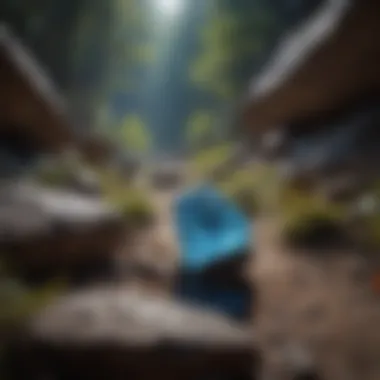

Role of Local Geologists
Local geologists are often the unsung heroes in the world of Yooperlite discovery. Their expertise provides the foundation upon which enthusiasts can build their understanding. These professionals have studied the regional rock formations diligently, highlighting the importance of geology in tracing patterns of natural artifacts on Earth.
- Key Characteristic: They act as custodians of knowledge, passing down insights gained from years of observation and study.
- Unique Feature: The collaborative efforts between geologists and collectors create a rich tapestry of experiences and knowledge sharing, fostering both respect and curiosity about the natural world.
In this way, the work of local geologists also elevates the practice of rock hunting into a more scholarly pursuit, broadening horizons for many along the way.
Cultural Significance
Beyond their geological characteristics, Yooperlites have woven themselves into the cultural fabric of Michigan's Upper Peninsula. The local folklore and storytelling involving these glowing rocks serve to enhance their appeal.
- Key Characteristic: They hold a special place in the hearts of many local communities, serving as conversation starters and symbols of pride.
- Unique Feature: Events such as annual rock-hunting festivals not only celebrate the tradition of collecting these stones but also strengthen local bonds and foster a sense of community.
As such, the cultural significance of Yooperlites makes them a celebrated treasure in Michigan, highlighting the connection between nature and community.
In sum, delving into the world of Yooperlites reveals layers of complexity ranging from their composition to their cultural relevance. This foundation sets the stage for exploring the role of black light in their fascinating discovery.
Significance of Black Light
The significance of black light in the realm of collecting and studying yooperlites cannot be underscored enough. These fascinating rocks don’t merely sparkle; they come alive with vibrant colors when exposed to ultraviolet light. In simple terms, the black light acts as a magic wand, revealing the hidden luminescence within yooperlites that is not visible under ordinary light. This makes black light an indispensable tool for rock enthusiasts and collectors alike.
Understanding Ultraviolet Light
Ultraviolet light, often referred to as UV light, sits just beyond the visible spectrum in the electromagnetic spectrum. Governed by its specific wavelengths, UV light is categorized into three bands: UVA, UVB, and UVC. For the practical purposes of identifying yooperlites, UVA is the main focus, as it is the type of UV light emitted by black lights. This range of light allows certain minerals, like sodalite, to fluoresce, hence drawing collectors and geologists to its use.
Interestingly, the interaction between UV light and minerals is more than just a show. It leads to various behaviors in materials, each dependent on their composition. Yooperlites, being rich in sodalite, exhibit unique fluorescence under UV light—each gleaming under specific conditions. So, in the context of yooperlites, black light is not just a tool, but a crucial element in revealing their profound beauty and character.
Mechanism of Fluorescence in Yooperlites
Role of Sodalite
Sodalite plays a pivotal role in the enchanting fluorescence bit of yooperlites. This mineral often makes up a good chunk of the syenite formation found in Michigan's Upper Peninsula. The key characteristic of sodalite is its ability to absorb UV light, which is then released in the form of visible light. This dazzling effect is what catches the eye of collectors, and it's also a significant factor in why people search for yooperlites.
What’s fascinating is that the more concentrated the sodalite, the more vibrant the glow. This means that yooperlites with higher sodalite content can create striking displays of luminescence, making them popular choices for both casual collectors and seasoned mineralogists. When it comes to advantages, sodalite is not only beautiful, but its presence is a clear indicator that you’ve stumbled upon something worth your time.
On the flip side, the specific conditions (like the angle and intensity of the UV light) affect how vividly the fluorescence is exhibited. Hence, understanding its role can enhance not just the identification of these stones but the appreciation of their beauty.
Factors Influencing Luminescence
Numerous factors influence the luminescence of yooperlites when subjected to black light. One of the most significant is the environment the rocks have undergone during their formation and lasting qualities in their surroundings. Specific aspects, such as temperature changes, mineral impurities, and the presence of moisture, can all affect how a yooperlite fluoresces.
The key characteristic here is variability. Different rocks may react differently under the same UV conditions due to these variations in their geological history. For instance, yooperlites from one locality might shine brighter than those from another simply due to the mineral makeup and surrounding conditions they experienced over time.
This variability greatly adds depth to the study and collecting of yooperlites. It not only keeps the hunt interesting but also provides endless opportunities for discovery and learning. However, it also means that collectors should be aware of these influencing factors to truly appreciate the wow-factor of their finds.
To sum it up, understanding these intricate details about black light and its interaction with yooperlites deepens one’s appreciation not just for the rocks themselves, but for the wider universe of geology as a whole.
The magical glow of yooperlites under black light is more than a visual delight; it’s a gateway into the mineral world’s hidden wonders.
Identification and Collection Techniques
The art of pinpointing and gathering Yooperlites is not just a hobby; it’s a delightful adventure that calls for both discernment and creativity. As curiosity leads enthusiasts to seek out these luminous treasures, understanding the techniques and methodologies for identification and collection becomes paramount in enhancing the experience.
Utilizing proper techniques not only facilitates the successful discovery of Yooperlites but also enriches the collector’s knowledge about these geological marvels. This section will delve into the tools and methods necessary to help identify and corral these glowing stones more effectively, ensuring that any adventure out there is as fruitful as it is enjoyable.
Using Black Light for Identification
This subsection is pivotal, given that black light is instrumental in the detection of Yooperlites. Without the right equipment and know-how, many potential finds could go unnoticed, lying hidden in plain sight.
Recommended Equipment
To kick off, one must understand the significance of selecting the right gear for spotting Yooperlites. A high-quality UV (ultraviolet) flashlight is perhaps the cornerstone of successful identification. The key characteristic here is the wavelength of light produced by these flashlights; they typically emit UV rays at around 365 nm, which is ideal for revealing the fluorescent glow of Yooperlites.
Recommended Equipment:
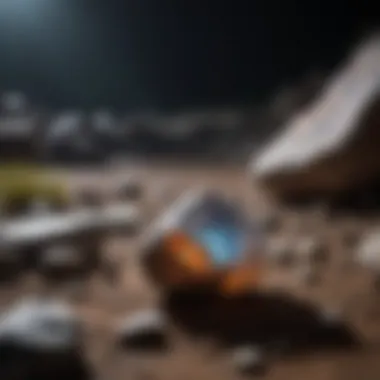

- Flashlights: A trusty UV flashlight like the Streamlight 51019 or LEDFlare often tops the list for enthusiasts. These devices provide a powerful light source that's relatively portable and easy to use.
- Safety Glasses: One might overlook this, but wearing safety goggles is advisable to protect one's eyes from UV exposure.
While the advantages of having top-notch equipment are apparent, some challenges may arise. For instance, cheaper flashlights may not emit the correct wavelength, causing frustration when the elusive stones remain hidden. Finding the right balance of quality versus price is thus a consideration for every adventurer.
In summary, reliable UV flashlights serve as a critical element in the identification process, making them a beneficial go-to for anyone eager to discover Yooperlites.
Effective Techniques
When it comes to effective techniques for uncovering Yooperlites, certain methods can streamline the identification process. One popular approach is sweeping the sand or rocky surfaces slowly with the UV light, allowing time to spot the luminescent glow. The key here is patience. Many enthusiasts tend to rush, eager to find treasures, but a calm and methodical approach usually yields better results.
Another technique involves examining the rocks during the evening or night, where the contrast between natural light and UV illumination is striking. You might also use reflective surfaces to enhance the light dispersal, making it easier to see those glimmering stones.
Effective Techniques:
- Scanning Method: Move the light in slow, sweeping motions while keeping an eye on the ground for any signs of luminescence.
- Night Hunting: Emphasizing the best conditions, night hunting allows for a clearer view of the Yooperlites’ fluorescence.
That said, some challenges could include finding a suitable spot for this technique if the area is too illuminated by street or moonlight. Nonetheless, learning and applying these effective techniques pay dividends in the pursuit of these remarkable stones.
Best Locations for Finding Yooperlites
Understanding where to hunt for Yooperlites is essential. Certain locales serve as havens for these glowing stones, which can lead to successful collection efforts.
Locality Insights
When it comes to localities, the area around the shores of Lake Superior, especially in Michigan's Upper Peninsula, is a hotspot for Yooperlite enthusiasts. The shoreline’s rocky environment provides a natural habitat for these stones, and their visibility increases during the right conditions.
Points to Note:
- State Parks: Certain parks like the Porcupine Mountains Wilderness State Park are known for clear and dark skies, which enhance UV detection.
- Beaches: Popular spots include the beaches at Grand Marais and Little Presque Isle, where Yooperlites tend to peek out from the sands.
However, it is essential to remember that while these regions are hotspots, the presence of other rock hunters can lead to competition. Thus, explorer’s discretion should be exercised in choosing less-travelled areas for hunting.
Seasonal Considerations
Timing plays a critical role in the success of Yooperlite hunting. Different seasons present unique situations for collectors. During late winter or early spring, melting snow reveals previously hidden stones. Meanwhile, the dry summer months offer easier access to rocky terrains.
Seasonal Tips:
- Winter/Spring: Use the thawing period to explore areas that may have been inaccessible.
- Summer: Warm weather makes for comfortable hunting experiences, but ensure to go during evenings for optimal visibility with UV light.
While each season has its advantages, one must also contend with varying weather conditions, which can affect visibility and accessibility. Tailoring your hunt based on the season can enhance the chances of uncovering these geological gems.
Against this backdrop, the art of identifying and collecting Yooperlites is as much about the techniques and tools as it is about understanding the environment and behaviors that will lead to successful discovery. Engaging in this hobby not only fosters a deeper connection with nature but also shares a sense of community among collectors.
Care and Preservation of Yooperlites
Caring for and preserving yooperlites is not just a matter of aesthetics; it speaks to the heart of a collector's relationship with these natural wonders. The importance of proper care cannot be overstated, especially considering their unique luminescent characteristics which make them appealing to both collectors and enthusiasts. Over time, without adequate safeguards, yooperlites can lose their shine or even get damaged, thereby diminishing their value and beauty.
The benefits of investing effort into preservation include maintaining their vivid fluorescence under black light, enhancing their geological intricacies, and ensuring they can be appreciated for years to come. Collectors will find that taking the time to understand and implement effective storage and cleaning methods will not only protect their collection but also enhance the overall experience of owning these geological anomalies.
Storage Recommendations
When it comes to storing yooperlites, choosing the right environment is crucial. Ideally, they should be kept in a cool, dark place, away from direct sunlight which can fade their luminescent features. A few helpful storage tips include:
- Use padded containers: A soft lining can absorb shocks, protecting yooperlites from scratches and other damage.
- Avoid stacking: Stacking can cause pressure and lead to cracks; better to keep them side by side.
- Label: For those with varied pieces, clear labeling can help in organization and showcase individual characteristics.
By implementing these practices, collectors can secure the appearance and quality of their treasures, allowing them to shine bright with each reveal under black light.
Cleaning Techniques
Safe Methods
Finding safe methods for cleaning yooperlites is essential for preserving their unique qualities. Gentle cleaning techniques often involve using soft brushes or microfiber cloths to remove dirt or dust without scratching the surface. Warm soapy water mixed with a mild detergent can be effective, but it is important to rinse thoroughly to avoid residue.
A key characteristic of safe methods is that they do not involve harsh chemicals, which can degrade the minerals and affect their fluorescence. This gentle approach appeals to many collectors who want to maintain both the integrity and aesthetic value of their yooperlites.
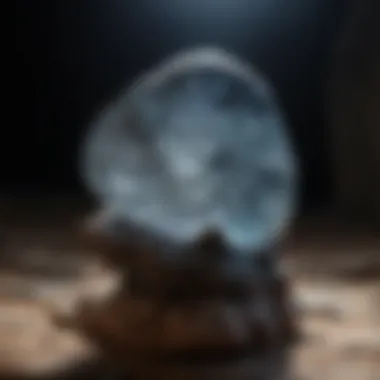
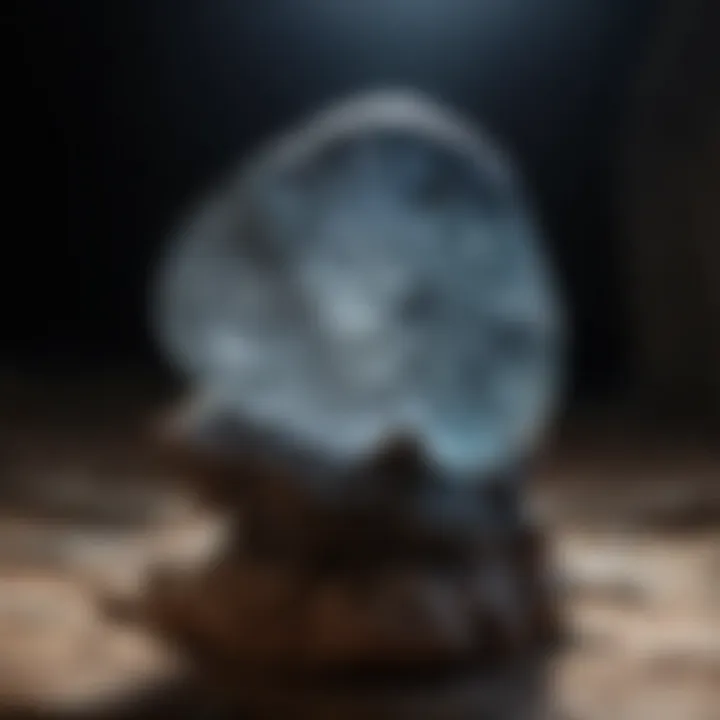
Keep in mind, avoiding abrasive scrubbing pads or cleaners ensures the natural luster remains intact, allowing each piece’s beauty to truly shine.
Preventing Damage
Preventing damage should also be a priority when dealing with yooperlites. One way to minimize risks is to keep them in low-traffic areas of your collection space. Avoiding environments prone to humidity or extreme temperatures can also help preserve their integrity.
Another intelligent tactic involves placing your collections in display cases with UV-filtering glass to block harmful light rays. This option maintains the elements’ integrity while allowing for a visual showcase.
The unique feature of prevention is that it requires less effort over time compared to dealing with restoration. It’s the difference between caring for something consistently versus trying to fix issues after they arise.
"An ounce of prevention is worth a pound of cure."
In sum, taking the right steps in both storage and cleaning not only upholds the captivating nature of yooperlites but also fosters a deeper appreciation for these geological gems. Collectors who invest time in proper care find it pays off with each black light experience—turning simple ownership into a thriving passion.
Community and Networking
Community and networking are integral components of the world of yooperlites, providing opportunities for interaction and knowledge sharing among enthusiasts. The vibrant community surrounding this unique mineral not only fosters a passion for collection but also elevates the understanding of its geological significance. Engaging with others who share a common interest enhances the overall experience of discovering, collecting, and preserving yooperlites.
Join the Yooperlite Community
Online Forums
Online forums serve as a dynamic platform for enthusiasts to connect, share insights, and seek advice related to yooperlites. These forums are characterized by their accessibility, allowing collectors from various parts of the world to participate in discussions that might otherwise be challenging. One significant advantage of online forums is the ability to gain diverse perspectives, reflecting a broad range of experiences and knowledge.
For instance, enthusiasts can share photos of their finds and receive immediate feedback or tips on identification techniques. Furthermore, the chance to engage with experienced collectors can expose newcomers to invaluable advice. However, like any community platform, the quality of information can vary, sometimes leading to misconceptions if not critically assessed.
Local Clubs
Local clubs provide a face-to-face dimension to yooperlite enthusiasts’ networking experience. The greatest feature here is the in-person interaction, which often cultivates a sense of camaraderie among members. Clubs frequently organize field trips to prime collecting sites, enhancing the learning curve while fostering friendships that go beyond discussions of yooperlites.
Participating in these clubs can benefit members by offering resources such as workshops on proper identification, preservation techniques, or even the science behind luminescence. However, one potential downside might be the geographical limitation; not all enthusiasts have access to active clubs. Despite this, the personal bonds formed in local settings often outweigh such inconveniences.
Sharing Collections
Photography Tips
Photography plays a crucial role in sharing collections of yooperlites, showcasing the unique qualities and stunning luminescence that these stones possess. Mastering photography can greatly enhance how one presents their collection, making it visually appealing in forums, clubs, or social media. A key characteristic of good photography in this context is the use of proper lighting, especially since showcasing luminescent properties under black light adds an extra dimension to the images.
Enthusiasts can experiment with different settings and techniques to capture the vibrancy and details of their finds. Although it requires practice, the satisfaction of presenting eye-catching photos can drive engagement and inspire further discussions and interest within the community. The main drawback, perhaps, is the learning curve associated with photography, which may discourage some collectors from sharing their findings.
Highlighting Unique Finds
Showcasing unique finds serves not only as a personal declaration of achievement but also benefits the broader community. Highlighting these pieces can stimulate conversations about geology, luminescence, and collection strategies, enriching the overall pool of knowledge. A significant characteristic of this aspect is that it encourages storytelling; each unique find often comes with a backstory that can captivate an audience.
This practice can also serve as an educational tool, sparking discussions that guide novice collectors on what to look for and the significance of certain characteristics. However, one must be cautious of over-commercialization or the pressure to find something spectacular, which can overshadow the simple enjoyment of the hobby. In the end, highlighting unique finds bolsters community engagement, inviting curiosity and fostering inspiration.
The End and Future Insights
The journey into the world of yooperlites leaves one pondering not only the intricate beauty of these stones but also the vast possibilities that lie ahead in the realm of geological exploration. Understanding the significance of black light in the identification of these luminescent gems spurs an appreciation for the natural world and the science behind the phenomenon. It encourages hobbyists and researchers alike to delve deeper, bringing to light discoveries yet to be made.
Reflecting on the Journey
Reflecting on this journey reveals a tapestry woven from passion, science, and community. Yooperlites provide a window into Michigan's geological past, and their glow serves as a reminder of the magic that lies beneath our feet. Collectors often recount the thrill of discovery, whether it’s a solo quest along Lake Superior's shores or a shared adventure with fellow enthusiasts. Each yooperlite tells a story of elemental creation, waiting for the right conditions—like exposure to black light—to reveal its secrets.
As collectors develop their skills in identifying and preserving these stones, they not only enrich their personal collections but also the collective knowledge about their formation and significance. Each hunt is not just about physical stones but the connection it fosters among those who share this niche passion. It is this camaraderie that makes the journey worthwhile, as enthusiasts swap tales and tips, igniting curiosity and excitement.
Potential for Future Discoveries
The future holds much promise for discoveries related to yooperlites and their luminescent properties. With advancements in technology and increasing interest in mineral collecting, there are several paths worth exploring.
Research Opportunities
One significant avenue is the realm of research opportunities. Numerous universities and geological institutions are keen on studying luminescent minerals, making this a thriving field for science. Engaging with academic circles not only enhances our understanding of fluorescence in minerals but may also lead to the identification of new yooperlite locations or even different luminescent minerals.
Key characteristics of this research lie in its collaborative nature—often requiring input from multiple disciplines, such as geology, chemistry, and even environmental science. This multi-faceted approach encourages a comprehensive understanding and appreciation of our environment. For enthusiasts, contributing to scientific studies can be deeply rewarding, as it adds valuable context to their collections.
Expanding the Hobby
Another promising trajectory is the expansion of the hobby itself. With online platforms blooming, enthusiasts can connect globally. Social media groups and dedicated websites for sharing discoveries mean that the community continues to grow exponentially.
The unique feature here is the potential for global exchange—what one collector discovers in Michigan may inspire another in Europe or Asia. This cross-pollination of ideas and techniques keeps the interest alive and offers fresh perspectives on how to collect, preserve, and study yooperlites.
While the vastness of this growth might feel overwhelming at times, it also enriches the experience, allowing collectors to learn faster and find support. Whether it’s through forums on Reddit or Facebook groups sharing tips and techniques, the enthusiasm remains contagious, ensuring the future of this hobby remains bright.



